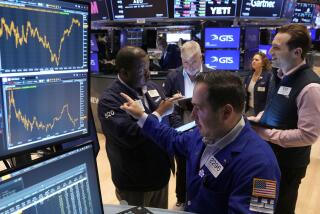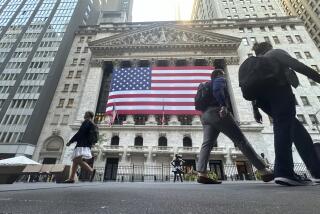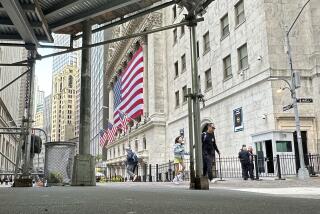Why the Dow Soared 88 Points : Wall Street: Analysts say several trends were at work in addition to an interest rate cut.
Wall Street’s surprise Monday rally was a striking reminder of how year-end trading crosscurrents make stocks even more unpredictable than usual.
The Dow Jones industrial average jumped 88.10 points, or 3%, to 3,022.58 in a buying surge that built steam throughout the day.
Near the close, the Dow was up almost 100 points, before falling back in the final minutes.
The rally was attributed largely to delayed optimism over the Federal Reserve’s full-point cut in interest rates on Friday, another attempt to jump-start the weak economy.
But experts also note that the end of the year--and start of the new year--often produce wild trading days and abrupt shifts in investor sentiment that can’t be easily explained.
Some of the crosscurrents at work in Monday’s trading:
* Quarter-end ‘window dressing’: Some large money managers shift their portfolios at the end of each quarter, tossing out losers so that clients don’t see those names on quarterly statements. At the same time, these managers may add stocks that they believe clients will want to see in the portfolio, based on the market’s current hot “theme.”
Though money managers routinely deny that window-dressing occurs, such trading could partly explain the rush Monday to buy stocks of home builders and various industrial companies that could benefit from last Friday’s cut in interest rates.
“I think there’s a feeling of, ‘You may as well get on board now (with such stocks), because if the economy improves, you have to be in,’ ” said Chris Pedersen, trader at Twenty-First Securities in New York.
* Short-covering: Short sellers are traders who target stocks they believe are ripe for a plunge. So they borrow stock and sell it, expecting to repay the stock loan later with shares purchased at lower prices. If market prices rise, however, the “shorts” lose money until they close out their positions.
Monday, as the market rose dramatically hour after hour, many panicked shorts apparently rushed in to buy stocks and thus end their bets on lower stock prices, traders said. The shorts’ buying thus helped propel the rally late in the day.
The urgency of the shorts’ buying may also have been affected by the approach of year’s end, because many short sellers--already badly wounded this year by the bull market--are thought to be desperate to avoid further losses.
* Tax-related selling: Many individual investors sell their stock dogs at the end of each year to realize losses that can offset capital gains. Such selling often weighs most heavily on smaller stocks--which may explain why the NASDAQ composite index of smaller stocks rose just 1.5% on Monday, half the Dow’s 3% rise.
Indeed, while blue chip stocks surged, “I saw a little bit of tax selling here,” said Larry Rice, head of NASDAQ trading at Wedbush Morgan Securities in Los Angeles.
Experts also note that tax-related selling doesn’t necessarily end Dec. 31. Early in January of this year, investors surprised Wall Street by dumping many of the food and drug stocks that had held up well throughout the late-1990 bear market. In retrospect, it appears that investors waited to sell those stocks at a profit in the new tax year rather than take the gains in 1990.
“The big question now is, what happens after Dec. 31, when you’ve got people sitting there with all these gains” from the 1991 bull market, said Peter Anderson, money manager at Federated Investors in Pittsburgh.
If investors are counting on a capital-gains tax cut in 1992, many may be waiting to sell as the new year begins, Anderson said--which could quickly derail any stock rally.
Technical trading trends aside, though, money managers admit that much of Monday’s buying was based on bona fide optimism about an economic recovery--and the feeling that there’s too much risk in being out of the stock market.
“There’s a new fear of being left behind,” Pedersen said.
Among the market highlights:
* Industrial, airline and railroad stocks led the rally on the expectation that they will benefit first from any economic recovery. Winners included machinery maker Ingersoll-Rand, up 2 1/2 to 49; Delta Air, up 2 3/4 to 62 5/8; and rail giant Union Pacific, up 3 to 49 5/8.
* Home builders and other beneficiaries of lower interest rates also rose sharply. Among builders, Kaufman & Broad soared 2 3/4 to 17 1/4, Centex rose 2 1/8 to 42 1/8 and Standard Pacific gained 3/4 to 8 3/8.
* Among lenders, Countrywide Credit rocketed 4 to 37 7/8, Coast Savings gained 3/4 to 6 7/8 and Federal Home Loan Mortgage jumped 5 1/8 to 113 1/2.
* Retailers also rebounded sharply on hopes for stronger consumer spending. Nordstrom rose 2 to 35 1/2, J.C. Penney was up 3 to 51 7/8, Wal-Mart added 1 7/8 to 55 1/4 and Toys R Us zoomed 2 to 30 1/4.
In overseas markets before Wall Street’s opening, most shares were lower. In Frankfurt, the DAX index lost 3.57 points to 1,539.62. In London, the Financial Times-100 index fell 12.7 points to 2,345.40. The Tokyo market was closed for a holiday.
Credit
Yields on long-term bonds plunged Monday, falling to the lowest level in nearly five years and extending a rally sparked by the Federal Reserve’s interest rate cut Friday.
The Treasury’s bellwether 30-year bond gained 3/4 point, or $7.50 per $1,000 in face amount. Its yield slid to 7.52% from 7.58% Friday, hitting its lowest level since March 19, 1987.
Economists said Monday’s activity was a carry-over from the cut in the Fed’s discount rate to 3.5% from 4.5%.
However, other short-term rates rose slightly Monday, backing up from big drops Friday. The three-month T-bill yield, for example, rose to 3.87% from 3.77% Friday.
The federal funds rate, the interest on overnight loans between banks, was quoted at 4.375%, down from 4.875% Friday.
Currency
The dollar tumbled further in reaction to the widening interest rate gap between the United States and Europe, but a late rally on Wall Street helped the U.S. currency partly recover.
In New York, the dollar plunged to 1.513 German marks, down from 1.534 Friday but above its intra-day low of 1.506. The dollar now is at its lowest versus the mark since February.
Against the Japanese yen, the dollar fell to 126.65 yen, down from 127.55 Friday.
Commodities
The weak dollar raised prospects for continued strong exports of agricultural goods, pushing wheat and soybean futures prices up sharply on the Chicago Board of Trade. Oat futures also rose; corn futures were mixed.
On other commodity markets, oil futures rose; precious metals rallied, and livestock and meat futures were mixed.
Light sweet crude oil for delivery in February rose 26 cents to $18.78 a barrel; January wholesale home heating oil climbed .76 cent to 51.84 cents a gallon; January unleaded gasoline climbed .75 cent to 52.99 cents a gallon.
Silver rose strongly and gold rose modestly in quiet trading on New York’s Commodity Exchange.
December gold rose 70 cents to $359.30 an ounce; December silver climbed 6 cents to $3.899 an ounce.
Market Roundup, D8
The Dow’s Climb The Dow Jones industrial average on the quarter hour. Friday’s close: 2,934.48 Monday’s close: 3,022,58
Airline, Rail and Industrial Stocks Lead Market Surge
The biggest gainers in Monday’s rally were stocks most likely to benefit quickly from an economic upturn.
Monday Monday Percent Stock close change change Ford Motor 27 7/8 +2 5/8 +10.4% AMR (American Air) 68 7/8 +6 1/8 +9.8% Georgia-Pacific 53 3/4 +4 3/4 +9.7% Intl. Paper 67 1/2 +4 3/8 +6.9% Caterpillar 41 1/2 +2 3/8 +6.1% UAL (United Air) 137 3/4 +7 3/4 +6.0% Conrail 75 1/4 +3 7/8 +5.4% Monsanto 64 3/8 +3 1/4 +5.3% Alcoa 62 +2 5/8 +4.4% Dow industrials 3,022.58 +88.10 +3.0%
MAIN STORY: A1
More to Read
Inside the business of entertainment
The Wide Shot brings you news, analysis and insights on everything from streaming wars to production — and what it all means for the future.
You may occasionally receive promotional content from the Los Angeles Times.










